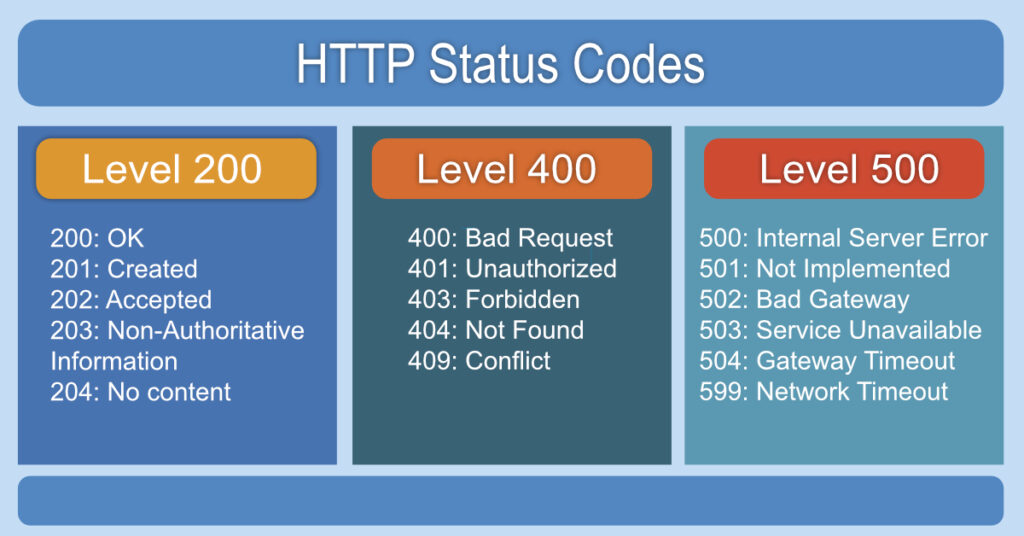In the vast landscape of the internet, HTTP status codes are the silent messengers that convey crucial information about the outcome of web requests. HTTP status code are three-digit numeric codes returned by web servers to indicate the result of a client’s request. They are divided into five categories, each serving a specific purpose:
- 1xx Informational: Indicates that the request was received and understood.
- 2xx Success: Indicates that the request was successfully received, understood, and processed.
- 3xx Redirection: Indicates that further action needs to be taken to complete the request.
- 4xx Client Error: Indicates that the client’s request contains incorrect syntax or cannot be fulfilled.
- 5xx Server Error: Indicates that the server failed to fulfill a valid request due to an error on the server’s end.

Example of Status Code
- 200 OK: This status code indicates that the request has succeeded. The server has fulfilled the client’s request, and the response contains the requested resource or action.
- 404 Not Found: This status code indicates that the server cannot find the requested resource. It is commonly used to indicate that the URL or resource does not exist on the server.
- 301 Moved Permanently: This status code indicates that the requested resource has been permanently moved to a new URL. The client should update its links to the new URL provided in the response.
- 400 Bad Request: This status code indicates that the server cannot process the client’s request due to invalid syntax or parameters. It is typically used to indicate errors in the request made by the client.
- 500 Internal Server Error: This status code indicates that the server encountered an unexpected condition that prevented it from fulfilling the client’s request. It is a generic error message returned when no more specific error message is suitable.
- 401 Unauthorized: This status code indicates that the client must authenticate itself to access the requested resource. It is commonly used when the client’s request lacks proper authentication credentials or authorization.
- 503 Service Unavailable: This status code suggests temporary server issues, such as maintenance or overloading, preventing request handling momentarily. It suggests that the client should try again later.
- 204 No Content: This status code indicates that the server successfully processed the request but is not returning any content in the response body. It is commonly used for requests that do not require a response body, such as successful DELETE requests.
Advantages of HTTP Status Code
- Clear Communication: HTTP status codes provide clear and concise communication between clients and servers, allowing both parties to understand the outcome of web requests instantly.
- Error Handling: Status codes help developers identify and troubleshoot errors efficiently by providing specific information about the nature of the error (e.g., client-side error vs. server-side error).
- Redirection: Redirection status codes (3xx) enable seamless navigation and URL forwarding, allowing websites to maintain consistency and improve user experience.
- SEO Optimization: Proper use of HTTP status codes, such as 301 redirects for permanent URL changes, can positively impact search engine optimization (SEO) by preserving link equity and avoiding duplicate content issues.
Conclusion
In conclusion, HTTP status codes are indispensable tools for web communication, providing valuable insights into the outcome of web requests. With their advantages in clear communication, error handling, redirection, and SEO optimization, HTTP status codes play a vital role in enhancing the reliability, usability, and performance of web applications. Understanding and leveraging HTTP status codes effectively can significantly improve the user experience and ensure the seamless functioning of web services in the digital age.
Frequently Asked Question
Both codes show resource absence. 404 means general error, 410 means permanent removal.
The 500-status code indicates server errors that other 5xx status codes do not specifically cover. It typically indicates an unexpected condition that prevented the server from fulfilling the request.
Some web frameworks and applications allow developers to define custom status codes for specific use cases, despite the standardization of HTTP status codes. However, it’s essential to adhere to HTTP standards and avoid conflicting with existing codes.

